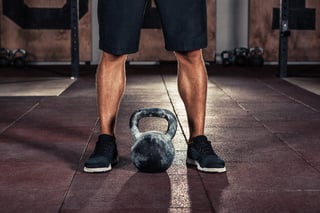 Whether you have been using kettlebells for years or you are new to using them, for your own safety, make sure you are not making these four common kettlebell mistakes.
Whether you have been using kettlebells for years or you are new to using them, for your own safety, make sure you are not making these four common kettlebell mistakes.
Not Using the Right Weight
Often people either go too heavy or too light. If you go too light, you are not going to get your desired workout. Going too heavy can be dangerous. It could lead to incorrect form, which may also lead to injuries, some of which may limit your ability to workout at all for a while.
In the beginning, focus on correct form, starting with a weight slightly lighter than you think you can handle. If, after several reps, that weight is too easy, move up a little at a time, until you find a weight that gives you a good workout with requiring you to sacrifice on form.
Focusing on the Number of Reps Rather Than Form
When using kettlebells or other workout equipment, people often focus on getting a specific number of reps. More important than achieving a specific number of reps is making sure you are using correct form. Incorrect form could lead to injuries to your back, arms, shoulders, and other body parts.
Your focus should be on using correct form. If you find your form deteriorating as you do more and more reps, you likely need to either do fewer reps or use a lighter kettlebell (maybe even both). If you are struggling to use proper form, practice with a really light object, such as a water bottle, in your hands.
Holding Your Breath
As is the case with many strenuous workouts, you may find yourself holding your breath as you lift your kettlebells. This is a bad mistake. It is important to continue to breathe in and out as you workout. If you find you are holding your breath, make a conscious effort to breathe. You may even want to enlist the help of a friend to watch you, making sure you are not holding your breath.
Wearing the Wrong Shoes
Thick-soled shoes, which are ideal for running or playing many sports, are not great for kettlebell training. Thicker shoes impair the movement of your feet, ankles, and lower legs. The cushioned heel also raises your foot off the ground, decreasing your foot’s grip with the ground.
Some people choose to go barefoot while using kettlebells. Of course, that is not for everyone. If you are not quite ready to completely ditch the shoes, thin-soled shoes also work well. They will allow you more movement of your feet and ankles, thereby helping with your overall kettlebell workout.
When it comes to personal training, using equipment properly should always be a top priority. Contact us to be connected with personal trainer, who can provide you with one-on-one training advice, so you can safely achieve your personal fitness goals.










